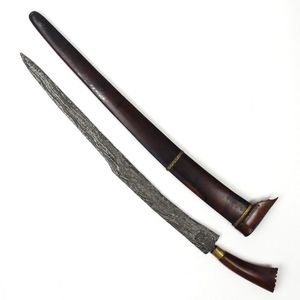Malay Parang Knife with Damascene Blade and Horn Hilt
You must be a subscriber, and be logged in to view price and dealer details.
Subscribe Now to view actual auction price for this item
When you subscribe, you have the option of setting the currency in which to display prices to $Au, $US, $NZ or Stg.
- Rosewood - A dense timber that varies in shade to very light brown to almost black. When rosewood is cut and sanded the colour of the timber will turn black, and after polishing and exposure to daylight, the surface will gradually lighten over time to light brown with black streaks.
The name comes from the odour emanating from the timber when it is planed, sanded or cut.
Rosewood was very popular for use in Victorian furniture in the second half of the 19th century, and at that time most of the rosewood was imported from Brazil. However it also grows in India and Indonesia.
It is used in the sold for chairs and table legs, but for carcase furniture such as side cabinets and bookcases, and for table tops it is always used as a veneer. - Damascene - Damascening is a technique used to decorate metal objects, such as swords, armor, and other metalwork, by inlaying different colored metals into grooves that have been etched or engraved into the surface of the metal. The technique is believed to have originated in Damascus, Syria, and was later adopted by other cultures such as the Japanese, Indians and Iranians.
The process typically involves etching a design into the surface of the metal, and then filling the grooves with a contrasting metal, such as gold or silver. The inlaid metal is then burnished to create a smooth surface, and the design is polished to a high shine. Damascening can create intricate and highly detailed designs, and is often used to decorate weapons, as well as jewellery, and other decorative objects.
This item has been included into following indexes:
Visually similar items

British 1907 pattern bayonet with leather steel mounted scabbard

19th century Aboriginal parrying shield. Curved, triangular section with rounded ends. Use patina. Some losses & insect damage. Provenance: Bungan Castle Museum collection. Length 66 cm

English hallmarked sterling silver George IV pair of asparagus servers having pierced blades, with original screws & guard, engraved with a stag armorial. London, 1826, maker Charles Eley. Condition: good minor tarnishing. Length 25.5 cm. Weight 177g

World War II Japanese Imperial army bayonet. Acquired Papua New Guinea. Length 53 cm
